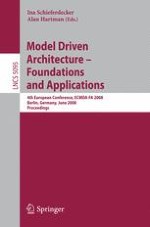The fourth edition of the European Conference on Model-Driven Architecture – Foundations and Applications (ECMDA-FA 2008) was dedicated to furthering the state of knowledge and fostering the industrialization of the model-driven architecture (MDA) methodology. MDA is an initiative proposed by the - ject Management Group (OMG) for platform-generic software development. It promotes the use of models in the speci?cation, design, analysis, synthesis, - ployment, and evolution of complex software systems. ECMDA-FA 2008 focused on engaging key European and international - searchers and practitioners in a dialogue which will result in a stronger, more e?cientindustry,producingmorereliablesoftwareonthebasisofstate-of-the-art research results. ECMDA-FA is a forum for exchanging information, discussing the latest results and arguing about future developments of MDA. It is a pleasure to be able to introduce the proceedings of ECMDA-FA 2008. ECMDA-FA addresses various MDA areas including model management, e- cutable models, concrete syntaxes, aspects and concerns, validation and te- ing, model-based systems engineering, model-driven development and servi- oriented architectures, and the application of model-driven development. Therearesomanypeople whodeservewarmthanksandgratitude.The fru- ful collaboration of the Organization, Steering and Program Committee m- bersandthevibrantcommunityledtoasuccessfulconference:ECMDA-FA2008 obtainedexcellentresultsintermsofsubmissions,programsize,andattendance. The Program Committee accepted, with the help of additional reviewers, research papers and industry papers for ECMDA-FA 2008: We received 87 s- missions. Of these, a total of 31 were accepted including 21 research papers and 10 industry papers. We thank them for the thorough and high-quality selection process.
